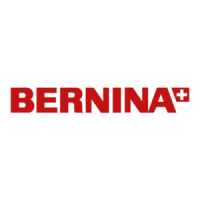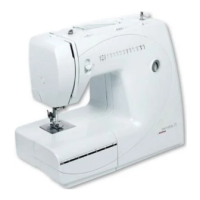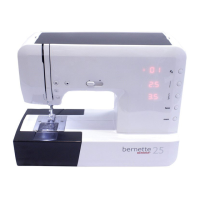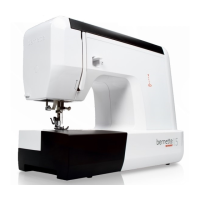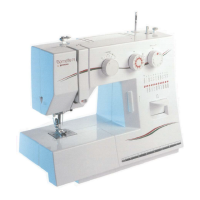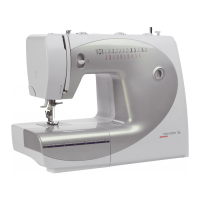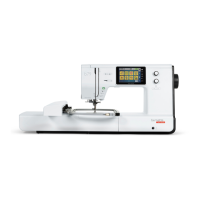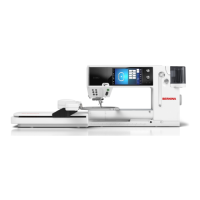Do you have a question about the Bernina Bernette 340 deco and is the answer not in the manual?
Immediate risks of electrical shock and precautions.
Risks of burns, fire, electrical shock, or injury, and general precautions.
Identification of key components of the sewing machine.
List and description of items included with the machine.
Instructions for attaching and removing the extension table.
Steps to safely connect the machine to an electrical outlet.
General usage guidelines, safety precautions, and notes.
Functionality and visual indicators of the start/stop button.
Operation and functionality of the automatic thread cutter button.
Procedure for safely removing the bobbin from the bobbin holder.
Guidance on correctly placing the thread spool on the pin.
Usage instructions for the extra spool pin, especially for metallic threads.
Step-by-step guide for winding thread onto a bobbin.
Correct procedure for inserting a wound bobbin into the machine.
How to adjust the presser foot height for easier hooping.
Detailed, illustrated steps for threading the upper thread.
Instructions for using the automatic needle threading mechanism.
How to bring the bobbin thread up to the needle area.
Guide to adjusting upper thread tension for optimal stitch quality.
Procedure for safely replacing the sewing machine needle.
Information on available embroidery hoops and their sizes.
Using hoop templates for accurate fabric positioning.
Step-by-step instructions for hooping fabric with stabilizer.
Procedure for mounting the hooped fabric onto the machine.
Types, properties, and applications of various embroidery stabilizers.
Overview of different thread types and their suitability for embroidery.
Guide to needle types, sizes, and their compatibility with fabrics.
Importance of regular needle inspection and replacement.
Explanation of basic operation keys on the machine's interface.
Inserting, ejecting, and basic use of design cards and USB sticks.
Customizing screen contrast, sound, eco mode, and speed.
Sewing light, thread cutter, thread selection, and memory formatting.
Selecting hoop size, auto stop, thread check, defaults, and language.
Accessing and navigating the machine's built-in help topics.
Navigating the main screen to select embroidery design sources.
How to access designs from internal memory, lettering, cards, and USB.
Browsing and selecting designs from available memory locations.
Procedures for deleting embroidery designs and folders from memory.
Information displayed and keys within the embroidery window.
Using jog keys, trace function, and stitch forward/backward keys.
Initial steps to begin an embroidery project, including thread cutting.
Steps to take and resolve when the upper thread breaks during embroidery.
Fonts, case selection, alphabet access, size, and delete key functions.
Creating text, selecting fonts, and positioning text on fabric.
Modifying text by deleting or inserting characters.
Creating monograms with built-in crests for personalized designs.
Combining designs, limitations on number of designs and stitches.
Choosing designs and using keys/drag-and-drop to position them.
Closing the editing window and selecting the appropriate hoop size.
Resizing, mirroring, rotating, deleting, and magnifying designs.
Example: merging a built-in design with custom text.
Storing created designs to internal memory, card, or USB stick.
Procedures for naming saved embroidery designs.
Methods for transferring designs via USB, ATA cards, and software.
Compatibility and capacity details for USB sticks and design cards.
Graphical overview of various methods to transfer embroidery designs.
Detailed procedures for transferring designs using different media.
Explanation of different embroidery file formats (.ART, .EXP, .EXP+).
Maintenance steps for cleaning the hook race and feed dog.
Instructions for safely replacing the machine's light bulb.
Immediate risks of electrical shock and precautions.
Risks of burns, fire, electrical shock, or injury, and general precautions.
Identification of key components of the sewing machine.
List and description of items included with the machine.
Instructions for attaching and removing the extension table.
Steps to safely connect the machine to an electrical outlet.
General usage guidelines, safety precautions, and notes.
Functionality and visual indicators of the start/stop button.
Operation and functionality of the automatic thread cutter button.
Procedure for safely removing the bobbin from the bobbin holder.
Guidance on correctly placing the thread spool on the pin.
Usage instructions for the extra spool pin, especially for metallic threads.
Step-by-step guide for winding thread onto a bobbin.
Correct procedure for inserting a wound bobbin into the machine.
How to adjust the presser foot height for easier hooping.
Detailed, illustrated steps for threading the upper thread.
Instructions for using the automatic needle threading mechanism.
How to bring the bobbin thread up to the needle area.
Guide to adjusting upper thread tension for optimal stitch quality.
Procedure for safely replacing the sewing machine needle.
Information on available embroidery hoops and their sizes.
Using hoop templates for accurate fabric positioning.
Step-by-step instructions for hooping fabric with stabilizer.
Procedure for mounting the hooped fabric onto the machine.
Types, properties, and applications of various embroidery stabilizers.
Overview of different thread types and their suitability for embroidery.
Guide to needle types, sizes, and their compatibility with fabrics.
Importance of regular needle inspection and replacement.
Explanation of basic operation keys on the machine's interface.
Inserting, ejecting, and basic use of design cards and USB sticks.
Customizing screen contrast, sound, eco mode, and speed.
Sewing light, thread cutter, thread selection, and memory formatting.
Selecting hoop size, auto stop, thread check, defaults, and language.
Accessing and navigating the machine's built-in help topics.
Navigating the main screen to select embroidery design sources.
How to access designs from internal memory, lettering, cards, and USB.
Browsing and selecting designs from available memory locations.
Procedures for deleting embroidery designs and folders from memory.
Information displayed and keys within the embroidery window.
Using jog keys, trace function, and stitch forward/backward keys.
Initial steps to begin an embroidery project, including thread cutting.
Steps to take and resolve when the upper thread breaks during embroidery.
Fonts, case selection, alphabet access, size, and delete key functions.
Creating text, selecting fonts, and positioning text on fabric.
Modifying text by deleting or inserting characters.
Creating monograms with built-in crests for personalized designs.
Combining designs, limitations on number of designs and stitches.
Choosing designs and using keys/drag-and-drop to position them.
Closing the editing window and selecting the appropriate hoop size.
Resizing, mirroring, rotating, deleting, and magnifying designs.
Example: merging a built-in design with custom text.
Storing created designs to internal memory, card, or USB stick.
Procedures for naming saved embroidery designs.
Methods for transferring designs via USB, ATA cards, and software.
Compatibility and capacity details for USB sticks and design cards.
Graphical overview of various methods to transfer embroidery designs.
Detailed procedures for transferring designs using different media.
Explanation of different embroidery file formats (.ART, .EXP, .EXP+).
Maintenance steps for cleaning the hook race and feed dog.
Instructions for safely replacing the machine's light bulb.
| Stitch Width | 5 mm |
|---|---|
| Stitch Length | 4 mm |
| Buttonhole Styles | 1 |
| Presser Feet | 4 |
| Speed Control | Yes |
